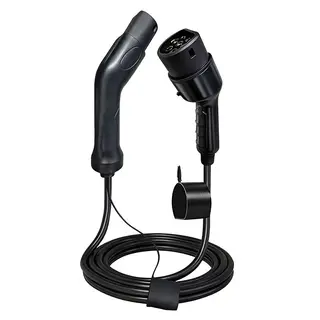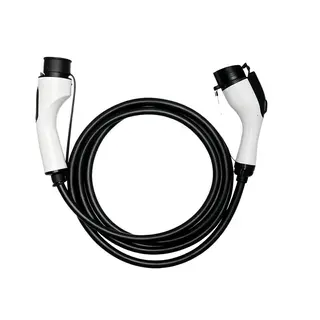With the popularity of electric vehicles, charging piles, as their important supporting facilities, have also gradually entered the public eye. However, faced with the wide variety of charging piles on the market, many car owners may feel confused: what is the difference between AC charging piles and DC charging piles? What are their respective advantages and disadvantages? How can one choose the charging pile most suitable for themselves? This article will answer these questions in detail and help you better understand electric vehicle chargers.
Before delving into the key points of selecting an electric vehicle charging pile, we first need to understand the basic principles of AC charging piles and DC charging piles.
AC charging piles are devices that provide power to electric vehicles equipped with onboard chargers. Their main function is to supply alternating current to the onboard charger of the electric vehicle, which then converts AC into DC to charge the battery. Since the power of the onboard chargers of electric vehicles is generally relatively small, AC charging piles cannot achieve fast charging. The charging speed of AC charging piles is relatively slow, usually requiring several hours to fully charge the battery of the electric vehicle, with a charging rate generally between 0.5C–0.25C. However, this slow charging method also has its advantages: it can effectively protect the battery and extend its service life.
DC charging piles are devices that directly charge the battery of electric vehicles. They can adjust the output voltage and current according to the battery management system (BMS) of the electric vehicle, and their functions are much more complex than those of AC charging piles. Since DC charging piles can directly charge the battery of electric vehicles, they generally adopt a three-phase four-wire system or three-phase three-wire system for power supply. The output voltage and current have a wide adjustable range, enabling fast charging of electric vehicles, and thus they are widely used. The charging speed of DC charging piles is very fast, usually requiring only 30 minutes to 1 hour to fully charge the battery of the electric vehicle.
Next, we will explore the advantages and limitations of AC charging piles, which will help you more comprehensively evaluate whether AC charging piles meet your needs.
Low cost: The construction and maintenance costs of AC charging piles are lower than those of DC charging piles, which is one of the reasons why they are popular. They can be used at home, making them an economical choice for private charging piles.
Battery protection: Since the charging speed of AC charging piles is relatively slow, they can effectively protect the battery and extend its service life.
Lower price: In terms of price, AC charging piles are cheaper compared to DC charging piles, which is a great attraction for car owners with limited budgets.
Slow charging speed: The charging speed of AC charging piles is relatively slow, requiring several hours to fully charge the battery of the electric vehicle, which is very inconvenient for car owners who need the vehicle urgently or for long-distance travel.
Not suitable for long-distance travel: Due to the long charging time, AC charging piles are not suitable for long-distance travel. If the battery runs low during a trip, using AC charging piles may cause significant delays.
After discussing the basic principles of AC and DC charging piles, we will now analyze the advantages and limitations of DC charging piles in depth. This will help you more comprehensively understand whether DC charging piles meet your needs.
Fast charging speed: DC charging piles are fast-charging devices with very high charging speed, usually requiring only 30 minutes to 1 hour to fully charge the battery of an electric vehicle. This is very convenient for car owners who need the vehicle urgently or for long-distance travel, greatly improving the practicality of electric vehicles.
Complex functions: DC charging piles can adjust output voltage and current according to the battery management system (BMS) of the electric vehicle, and their functions are much more complex than those of AC charging piles. Through charging pile technology, group management and flexible charging can be effectively realized, optimizing investment and return on investment.
Wide applicability: DC charging piles are suitable for newly built communities, parking lots, and other places with high charging mobility, meeting the needs of different users.
High cost: The overall cost of DC charging piles is high, and the installation cost is also relatively high. In some cases, the cost of wiring can even exceed the cost of the equipment itself, which poses great difficulties for older communities or areas with underdeveloped distribution facilities.
High distribution requirements: The charging power of DC charging piles is generally between 60 kW and 80 kW, with single-gun input current reaching 150 A–200 A, which is a huge test for the power supply line. Ordinary community transformers can hardly support several such charging piles, and older communities may not even be able to install one.
Large equipment investment: Whether single-gun, dual-gun alternate, or dual-gun simultaneous charging DC piles, the equipment investment is relatively large. In addition, upgrade and modification costs are also higher, which may place a certain economic burden on small enterprises and individual users.
Next, let us explore the key points for selecting charging piles. These will help you choose the charging pile most suitable for yourself from among the many products.
Before purchasing a charging pile, you must understand your vehicle's charging power. Since different models support different maximum powers, if your car can only accept 7 kW charging power, even if you purchase a high-power charging pile, the charging will still be limited to 7 kW. Conversely, if your car supports 40 kW charging but you purchase only a 7 kW charging pile, charging may not be possible or will be significantly slowed.
Choose charging piles that can automatically stop when fully charged and that have protection functions such as overcurrent, short circuit, leakage, and emergency stop to ensure charging safety and personal safety. In addition, the charging gun head may heat up due to contact resistance. When conditions permit, test for about ten minutes: touch the gun head to ensure it is not too hot. If the temperature exceeds what the hand can comfortably withstand (around 60°C), stop charging immediately and replace the equipment.
According to activation methods, charging piles can be divided into plug-and-charge, card-swiping, and QR code scanning. Plug-and-charge is only suitable for portable charging piles. If fixed at a parking space, anyone can use your charging pile, which carries the risk of electricity theft. Card-swiping and QR code scanning are more suitable for fixed charging piles. Private charging piles can be set to non-billing mode, which is convenient and safe.
The most expensive charging pile is not necessarily the best. It is essential to consider your budget. Currently, whether AC or DC charging piles, prices range from a few thousand yuan to tens of thousands. The choice depends on individual needs—meeting expectations is the best choice.
Choosing a charging pile is not about higher power being better; instead, compatibility with your vehicle and charging functions must be considered comprehensively. Even charging piles with the same specifications may have price differences. The main reasons are: (1) different manufacturers and brand premiums; (2) different materials and components used, including housings, processes, circuit boards, and parts.
Remote control function: In many regions, electricity is billed at different times of day, with off-peak prices as low as one-third of the usual rate. Charging piles with remote control functions can schedule charging during off-peak hours to save costs.
4G communication function: Charging piles with 4G communication can be shared or used for commercial charging through software apps. The current cost of adding 4G is only around 20 yuan, making it very cost-effective.
Display screen function: Current charging pile technology has evolved through several generations. This reduces cost and enhances user experience. However, display screens have limitations: the lowest operating temperature is -20°C, making them unsuitable in northern regions of China and northern Europe during winter. Moreover, screens are fragile and are the most frequently damaged component in charging piles.
As an important supporting facility for electric vehicles, charging piles play a crucial role in their popularity and development. AC charging piles and DC charging piles each have their advantages and disadvantages, and car owners should choose the most suitable charging pile based on their actual needs and usage scenarios. When selecting a charging pile, factors such as charging power, safety performance, additional functions, and price should be considered comprehensively, aiming for a product that is cost-effective, safe, and reliable. At the same time, installation and maintenance of charging piles are also very important. Only with proper installation and regular maintenance can the charging pile operate normally and extend its service life. It is hoped that this article can help you better understand electric vehicle charging piles and choose the most suitable one, providing convenience and security for your electric vehicle travel.



